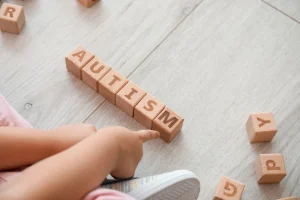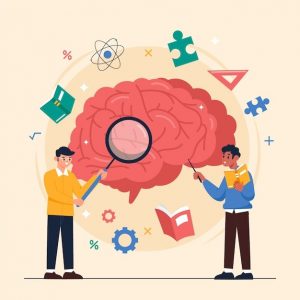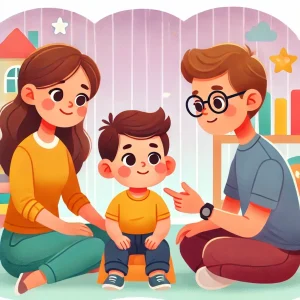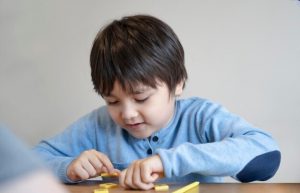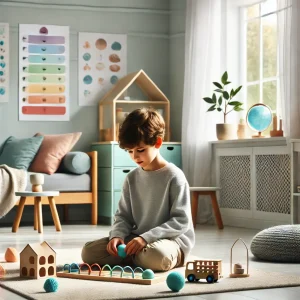Emotional Regulation Tips for Children with Autism and ADHD
By Wellness Hub
Last Updated: September 13, 2024
Managing emotions can be tough for anyone, but it’s especially challenging for children with Autism and ADHD. If you’re a parent, caregiver, or educator, you’ve likely seen how quickly these children can go from calm to overwhelmed. Loud noises, sudden changes in routine, or even something as simple as a scratchy tag on a shirt can trigger intense emotional responses. These reactions aren’t just “bad behavior”; they are often a child’s way of coping with feelings they can’t quite understand or control.
Emotional regulation is crucial because it helps children navigate their world more smoothly. When kids learn to manage their emotions, it reduces the frequency of meltdowns, eases social interactions, and even improves their ability to focus in school. Think of it as giving them a toolkit to handle life’s ups and downs. For children with Autism and ADHD, developing these skills can be life-changing. It’s not just about reducing outbursts; it’s about helping them feel more in control and confident.
What is Emotional Regulation?
Emotional regulation is the ability to manage and respond to our emotions in a healthy and appropriate way. For children, especially those with Autism and ADHD, this means learning how to recognize their feelings, understand why they feel a certain way, and find strategies to cope when emotions become overwhelming. It’s like having an internal toolkit that helps them stay calm, handle stress, and make better decisions—even when things don’t go as planned.
So, why is emotional regulation so important for children with Autism and ADHD? These children often face unique challenges that can make managing emotions a daily struggle. They might have heightened sensitivity to sensory inputs like noise or light, find it difficult to adapt to changes in routine, or struggle with understanding social cues. Without the skills to manage their emotions, these situations can quickly lead to frustration, anxiety, or meltdowns.
Also read: Emotional Regulation in Children: A Parent’s Guide to Helping
Identifying Emotional Triggers
Recognizing what triggers intense emotions in children with Autism and ADHD is a crucial step toward helping them manage those emotions effectively. Triggers can be anything from sensory overload—like loud noises or bright lights—to unexpected changes in routine or even specific social interactions. Understanding these triggers allows you to better prepare and support your child when challenging situations arise.
To start, observe your child closely. Notice patterns in their reactions: Are there specific times of day when they seem more irritable? Do certain environments or activities cause them to become overwhelmed? By paying attention to these details, you can begin to identify common triggers. For example, if your child becomes anxious in crowded places, that’s a clear signal of a trigger. The goal is to pinpoint these situations so you can either help your child avoid them or equip them with the tools to handle them better.
Using Tools Like Emotion Charts and Visuals
One effective way to help children understand and manage their feelings is through emotion charts and visual supports. These tools can simplify the complex process of identifying emotions, making it easier for children to express what they’re feeling and why. Emotion charts, which often use colors or facial expressions to represent different levels of emotion, can be placed in common areas like the kitchen or bedroom, serving as a constant visual cue for your child.
For example, a simple emotion chart might use green to indicate feeling calm, yellow for feeling slightly upset, and red for feeling very angry or overwhelmed. By referring to this chart, children can learn to associate their feelings with these visual cues, helping them to better articulate what they’re experiencing. Visual supports like these are particularly helpful for non-verbal children or those who struggle with expressing their feelings in words.
Common Emotional Triggers and Coping Strategies
| Trigger | Coping Strategy | Description |
|---|---|---|
| Loud Noises | Use noise-canceling headphones | Loud or unexpected noises can be overwhelming. Provide noise-canceling headphones or earplugs to reduce noise levels and help your child feel calmer in noisy environments. |
| Changes in Routine | Prepare with visual schedules | Changes in routine can cause anxiety. Use visual schedules or charts to show the day’s activities in advance, helping your child understand what to expect and feel more secure. |
| Crowded Spaces | Create a calm-down space or use deep breathing | Crowded spaces can be overstimulating. Identify a quiet corner or calm-down space where your child can retreat. Teach deep breathing exercises to help them manage feelings of stress in these environments. |
| Unexpected Changes | Use first-then statements to explain next steps | Unexpected changes can be confusing and frustrating. Use simple first-then statements like “First, we put on shoes, then we go outside” to provide clear guidance and help your child adjust to changes smoothly. |
Simple Tips for Managing Emotions
Managing emotions can be easier with a few simple strategies that you can use every day. Here are some practical tips to help children with Autism and ADHD calm down and feel more in control of their feelings.
1. Deep Breathing: Calm Down with Easy Breathing Exercises
Deep breathing is a quick way to help children relax when they feel upset. Teach your child to take slow, deep breaths by breathing in through the nose, holding for a second, and then breathing out through the mouth. You can make it fun by using a pinwheel or blowing bubbles. This simple exercise can be used anywhere and helps children learn to calm themselves.
2. Calm Down Space: Create a Relaxing Area
Setting up a calm-down space at home can give your child a safe spot to go when they need a break. This space can be a cozy corner with pillows, a favorite blanket, or a few comforting items like a stuffed animal or a fidget toy. Encourage your child to use this space whenever they feel overwhelmed, helping them learn it’s okay to take a moment to reset.
3. Visual Supports: Use Pictures and Charts
Visual supports like emotion charts can help children understand their feelings and what to do when they feel different emotions. Create a simple chart with colors or pictures that show feelings like happy, sad, or angry, and match them with actions like “take deep breaths” or “hug a toy.” Place these charts in easy-to-see spots at home, so your child knows what to do when emotions are high.
Also read: Fun 7 Activities to Boost Emotional Regulation in Young Children
Creating Coping Strategies
Helping children with Autism and ADHD develop coping strategies is essential for managing their emotions effectively. Simple tools and techniques can empower them to handle stressful situations better. Here are some practical ways to create coping strategies that can make a real difference.
1. Calm Down Kits: What to Include in a Kit to Help Children Manage Emotions
A calm down kit is a personalized collection of items that help children soothe themselves when they feel overwhelmed. These kits can be kept at home, in the car, or even taken to school. Here’s what you can include:
- Sensory Items: Fidget toys, stress balls, or a small stuffed animal can provide comfort and help focus their attention.
- Visual Aids: Emotion charts or calming visual cards can guide children through deep breathing or other calming exercises.
- Comfort Items: A favorite blanket, soft pillow, or anything else that makes your child feel safe.
- Distraction Tools: Coloring books, puzzles, or simple activities that shift their focus away from what’s upsetting them.
- Soothing Sounds: Include headphones with calming music or nature sounds to help block out overwhelming noises.
Calm down kits are a practical way to give children the tools they need to manage their emotions independently. It’s a simple yet effective strategy that can be tailored to your child’s preferences and needs.
2. Modeling Behavior: Show Children How to Stay Calm by Setting a Good Example
Children learn a lot by watching the adults around them, so modeling calm and positive behavior is crucial. If you stay calm during stressful situations, your child is more likely to mimic that response. For example, if you’re stuck in traffic, instead of showing frustration, try deep breathing and say out loud, “I’m feeling a little stressed, so I’m going to take some deep breaths to calm down.”
This not only sets a positive example but also teaches your child that it’s okay to feel upset and that there are healthy ways to manage those feelings. The more you demonstrate these behaviors, the more your child will learn to apply them in their own lives.
3. Practice Makes Perfect: Role-Play Different Scenarios to Teach Appropriate Emotional Responses
Role-playing is a fun and interactive way to teach children how to handle various emotional situations. You can act out common scenarios that your child might find challenging, such as losing a game, being told “no,” or meeting new people.
For instance, if your child often gets upset when losing, you can role-play a game where you pretend to lose gracefully. Show them how to say, “It’s okay, maybe next time I’ll win,” and practice smiling and congratulating the winner. By repeatedly practicing these scenarios, your child can build confidence and learn the right responses when faced with real-life situations.
Emotional Regulation Tools and Their Uses
| Tool | Purpose | How to Use |
|---|---|---|
| Deep Breathing | Helps calm the mind and body, reduces anxiety | Teach your child to breathe in slowly through their nose, hold for a count of three, and exhale through their mouth. Use visuals like a pinwheel or bubbles to make it engaging. |
| Calm Down Kit | Provides comfort and distraction during stress | Include items like fidget toys, stress balls, noise-canceling headphones, or a favorite stuffed animal. Encourage your child to use the kit when they start feeling overwhelmed. |
| Visual Supports | Guides understanding and expression of emotions | Use emotion charts with faces or colors to help your child identify and communicate how they’re feeling. Place these charts in common areas for easy access. |
| First-Then Statements | Helps with transitions and builds cooperation | Use statements like “First, brush your teeth, then story time” to help your child understand the sequence of tasks and what to expect next. Keep the language simple and clear. |
| Sensory Items | Reduces sensory overload and provides calming input | Include sensory tools like textured fabrics, weighted blankets, or soft lights. These can help soothe your child’s senses and offer a comforting distraction from triggers. |
Encouraging Positive Reactions
Helping children with Autism and ADHD respond positively to challenging situations can make a big difference in their emotional regulation journey. Teaching replacement behaviors and simple problem-solving skills can guide them toward more constructive reactions, reducing frustration and helping them feel more in control.
1. Replacement Behaviors: Teach Children What to Do Instead of Negative Reactions
When children face difficult emotions, they might react in ways that aren’t helpful, like yelling, hitting, or shutting down. Replacement behaviors are positive actions that children can learn to use instead of these negative responses. The goal is to teach them what they can do, rather than just focusing on what they shouldn’t do.
For example, if a child tends to shout when frustrated, teach them to use their words to express how they feel, such as saying, “I’m upset because I can’t find my toy.” You can also introduce calming techniques like squeezing a stress ball, counting to ten, or asking for a break. Visual aids, like behavior charts or simple reminder cards, can be helpful tools to reinforce these replacement behaviors, making it easier for the child to remember what to do in the moment.
The key is consistency and patience—praise your child when they use a positive behavior, even if it’s a small step in the right direction. This reinforces their efforts and encourages them to keep trying.
2. Problem-Solving: Simple Exercises to Help Children Feel in Control and Less Frustrated
- Essential Skills: Children with Autism and ADHD benefit significantly from problem-solving skills as they foster independence and the ability to handle daily challenges.
- Calm Approach: Teach your child to tackle problems calmly and systematically, which helps them reduce frustration and build confidence.
- Identify Problems: Start with simple exercises like identifying the problem with your child by asking, “What’s bothering you?”
- Brainstorm Solutions: If your child feels upset about missing a favorite book, guide them through a solution-seeking process: “Let’s think about where we last saw it. Should we check your room or the living room first?”
- Use Visual Tools: Implement “problem size” charts to help your child categorize issues as small, medium, or big. This approach simplifies the problem and aids in deciding the steps to address it.
- Role-Play Scenarios: Engage your child in role-playing different scenarios to strengthen their problem-solving skills in a fun and interactive manner.
- Practice and Mastery: Encourage frequent practice of these exercises, enabling your child to naturally apply them in real-life situations.
- Build a Toolbox: Focus on teaching replacement behaviors and problem-solving skills to equip your child with a robust set of responses for everyday challenges.
- Explore More: For detailed strategies and expert advice, visit Wellness Hub. We offer tailored support for children with Autism and ADHD.
Importance of Routine and Consistency
Having a routine can really help children with Autism and ADHD feel calmer and more in control. When they know what’s coming next, it reduces anxiety and makes transitions between activities smoother. Here are some simple ways routines and clear instructions can support emotional regulation.
Daily Routines: How Consistent Routines Can Help Manage Emotions
Daily routines provide a sense of predictability. When children follow the same steps every day—like getting up, brushing teeth, getting dressed, and having breakfast—they know what to expect. This can help reduce stress and make them feel more secure.
A bedtime routine, like reading a book before sleep, can also help your child wind down and feel ready for bed. Try to keep routines consistent, even on weekends, so there’s always a sense of what comes next. You can use a simple visual schedule or chart to show your child the order of activities, which helps them see and understand the plan for the day.
First-Then Statements: Simple Prompts to Guide Through Tasks
First-then statements are a straightforward way to guide your child through tasks. They help by breaking things down into two steps: “First, we do this, then we do that.” For example, you can say, “First, we put away the toys, then we can play outside.” This method clearly shows your child what needs to happen and what they can look forward to next.
These statements are easy to remember and provide a clear direction, making transitions between tasks easier and less overwhelming. Over time, they can help your child feel more confident and cooperative in their daily routines.
Keeping routines simple and using first-then statements can make a big difference in managing emotions. For more tips and resources, check out Wellness Hub where you can find more ways to support your child’s emotional well-being.
Conclusion
Supporting a child with Autism or ADHD on their emotional journey requires patience, understanding, and the right strategies. Simple tools like deep breathing, calm-down corners, and clear visual aids can significantly aid in managing their feelings, providing a sense of control and security. Consistency in daily routines and positive reinforcement enhances their ability to cope with daily stressors. While the progress might be gradual, each small victory is a step towards greater emotional resilience. Remember, you’re not alone in this journey—Wellness Hub is committed to offering resources and expert guidance tailored to meet your child’s needs. Together, we can foster a nurturing environment that empowers your child’s emotional development.
Frequently Asked Questions:
1. What are some effective emotional regulation tips for children with Autism and ADHD?
Effective tips include teaching deep breathing exercises, setting up a calm-down space, using visual supports like emotion charts, and practicing first-then statements to guide children through tasks.
2. Why is emotional regulation important for children with Autism and ADHD?
Emotional regulation helps children manage their reactions to stress and frustration, reduces meltdowns, and improves their ability to handle everyday challenges, leading to a calmer and more positive daily experience.
3. How can I create a calm-down kit for my child?
A calm-down kit can include items like fidget toys, stress balls, a favorite stuffed animal, headphones with calming music, and visual aids like emotion charts. The goal is to include items that help your child relax and refocus.
4. How can routines help with emotional regulation in children?
Consistent routines provide structure and predictability, which helps children feel more secure and less anxious. Knowing what to expect reduces stress and makes transitions between activities smoother.
5. What are first-then statements, and how do they help?
First-then statements are simple prompts that guide children through tasks by clearly stating what needs to happen first before moving on to something they prefer. For example, “First, finish your homework, then you can play.” This helps reduce resistance and keeps children on track.
6. How can parents support emotional regulation at home?
Parents can support emotional regulation by modeling calm behavior, maintaining consistent routines, using first-then statements, and creating a supportive environment with calm-down spaces and visual aids.
7. How can teachers help with emotional regulation in school?
Teachers can help by using visual schedules, providing clear instructions, offering calm-down spaces, and working closely with parents to ensure consistent strategies are used at both home and school.
8. What role does patience play in helping my child with emotional regulation?
Patience is key when supporting your child’s emotional regulation. Progress may be gradual, and being patient helps build trust and encourages your child to keep trying new strategies without feeling rushed or pressured.
9. Where can I find more resources to support my child’s emotional regulation?
Wellness Hub offers a range of resources and expert advice to help children with Autism and ADHD develop emotional regulation skills. Visit Wellness Hub for more information and support tailored to your needs.
10. How can I encourage positive reactions in my child with Autism or ADHD?
Encouraging positive reactions involves teaching replacement behaviors, such as using words instead of acting out when frustrated. Role-playing different scenarios can help your child practice appropriate responses in a safe and supportive environment. Praise and reinforce these positive behaviors consistently to help them become more natural for your child over time.
About Author:
Lasya Vooturi,
Clinical Psychologist (A) & Behavioral Therapist
Lasya holds a Professional Diploma in Clinical Psychology from Amity University, where she deepened her understanding of psychological principles from March 2023 to March 2024. With over a year of dedicated experience as a Behavioral Therapist, Lasya has honed her skills in applying effective therapy techniques tailored to individual needs. Fluent in Telugu, Hindi, and English, she is adept at connecting with a diverse range of clients, ensuring comprehensive communication and understanding. Lasya’s approach is grounded in empathy and scientific rigor, making her a trusted ally in navigating mental health challenges.
Book your Free Consultation Today
Parent/Caregiver Info:
Client’s Details:
* Error Message
